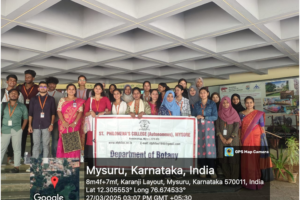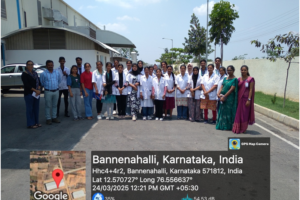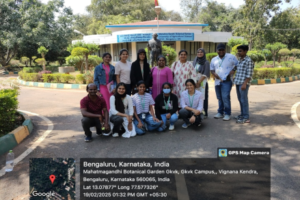
“MYMUL – Mysuru Milk Union Limited”

An industrial visit to
“MYMUL – Mysuru Milk Union Limited”
Held on 21th March 2022
PREAMBLE
Bacteria are microscopic, single-celled organisms that exist in millions, in every environment, both inside and outside other organisms. Some bacteria are harmful, but most serve a useful purpose. They support many forms of life, both plant and animal, and they are used in industrial and medicinal processes. One such use is in the dairy industry.
The production of milk on dairy farms and the processing of milk and milk products at dairy plants make up the dairy industry. Along with producing many kinds of milk, the industry makes butter, cheese, yogurt, sweets and ice cream. Lactobacillus spp. is Gram-positive rod bacteria, their phenotypic traits, such as homo-/heterofermentation abilities, play a crucial role in souring raw milk and in the production of fermented dairy products such as cheese, yogurt, and fermented milk (including probiotics). To understand the importance of microbes in our daily life and their products, it will be of great significance to visit any related industry.
OBJECTIVES
- To understand the importance of microbes in our daily life and their products.
- To understand the working of a dairy industry and the quality assurance.
- To give them practical education on industrial procedure and its facility.
ABOUT THE INDUSTRY
Mysore Dairy with the capacity of 10 TLPD was started in the year 1965 under the control of the Department of Animal Husbandry and Veterinary Services of Karnataka State, which was transferred to Karnataka Dairy Development Corporation in the year 1974. The capacity was expanded to 60 TLPD in 1980 under the scheme operation flood and transferred to the Karnataka Milk Federation in 1984. As per the Government policy the Dairy and its Chilling Centers were handed over to Mysore Milk Union on 01.06.1987. The capacity was expanded to 100 TLPD under the Operation Flood II and further expanded to 180 TLPD under Perspective Plan I Programme.Later capacity was expanded to 300 TLPD. Consequent to the bifurcation of Mysore District into Mysore and Chamarajanagar Districts, this Union is renamed as Mysore-Chamarajanagar District Co-op Milk Producers Societies Union Ltd. Later from April 2015 Bifurcation of Mysore-Chamarajanagar distict milk union as Mysore milk union and Chamarajanagar milk union.The new Mega dairy plant is installed with capacity 6 LLPD expandable to 8 LLPD at Alanahally Mysore.

ABOUT THE INDUSTRIAL VISIT
Industrial visit is a part of curriculum, so the students were taken to MYMUL to gain the practical knowledge on industrial practices. We were accompanied by Mr. Charamanna, he guided us through various departments and sections of the KMF unit. He explained that there are 1250 societies in MYMUL, this industry is directly connected to farmers. At specific time, everyday, milk is weighed and collected in tankers and are brought to the milk reception in MYMUL. In milk reception, the milk is separated and processed to various divisions. There is an automatic receiver which is connected to the tanker and thus, milk is collected. The sample is then subjected to various tests based on which the milk is sent to designated division for further processing.
Further, there is a process hall which contains cream separator. If the milk sample does not match BMC sample, then the milk is rejected. Based on the milk quality, farmer gets the value. Next unit was ghee production area. Butter is processed into ghee which is further packed using advanced packing system and then sent to cold storage unit.
Further we moved on to butter processing unit. There were a range of butter types, for example, salted butter, unsalted butter, sliced butter and butter cubes.

Mr. Charamanna said that there are supposedly 165- Nandini products. We saw the sachet section where 5 varieties of milk and 2 varieties of butter curd are packed.

Then came the sweets section we witnessed how peda and basan laddoo are prepared. Panneer making section was truly interesting. We had been to milk cold room and boiler section as well. We came to know how the heat is generated for the functioning of various plants that is by using coffee husk, corn husk and briquettes.

OUTCOME OF THE INDUSTRIAL VISIT
- Students could understand the processes of dairy industry, from the farmer to the consumer.
- Students were greatly amazed by the quality testing, variety of products and the packaging.
- Students could practically understand the importance of microbes in dairy industry.

FEEDBACK
Students were allowed to visit different departments and a brief explanation and working procedures of the same were well explained. Since the number of students were more, it was difficult to divide them into batches and it would have been better if there were two guides to explain.





